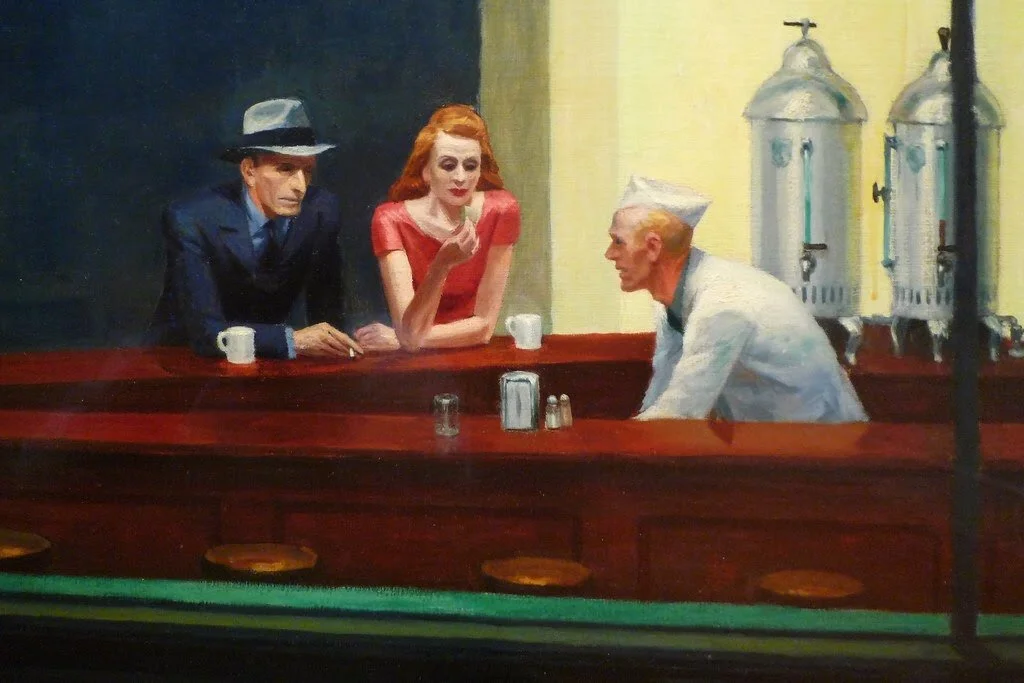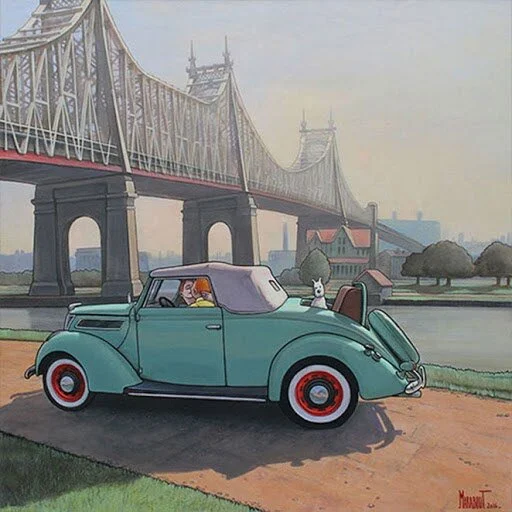That’s Original: On The Vagaries of Copyright Laws
The grey area between fair use and exclusive rights is a minefield for most people working in the creative field. Copyright laws are difficult to grasp, and even more tricky to wield. So, how do we decide what counts as infringement and what doesn’t? The cautionary tale that follows has an ending that may surprise you.
From the 1930s through 50s, a Belgian caricaturist wrote a series of children’s books featuring a quick-thinking reporter who travelled the world with his dog. Hergé, the cartoonist, drew life into Tintin, the titular character, making him honest, empathetic and generous. With a rounded face and blonde quiff, his eternally youthful appearance became iconic, synonymous with heroic action and good-natured mystery solving.
The Adventures of Tintin mural painting by Hergé. Location: Rue de l’Etuve
At around the same time, an American realist painter named Edward Hopper was conjuring stark urban scenes draped in unusual lighting that evoked heavy emotions; loneliness, regret, boredom. His compositions of the American metropolis at night were poignant and moody; the characters placed within them were often dejected, anxious and melancholic.
Hopper, Nighthawks with detail of trio
Years later, a French artist named Xavier Marabout drew these two disparate worlds together, building a connection between Tintin’s whodunnits and the enigma of Hopper’s paintings, and doing so without license or permission.
Marabout copied Hopper’s seedy urban landscapes and placed Hergé’s boy adventurer at the heart of them, making him interact with provocative pin-ups; sharing a drink with one in Hopper’s famous Nighthawks, kissing another in an imitation of Queensborough Bridge.
“I imagined a romantic life for Tintin in the intimate and voyeuristic universe of the American painting. Because frankly, the universe of Hergé is terribly virile and women are completely absent. Who can imagine a world without women? So my paintings where Tintin is staged with pin-ups are funny.”
Moulinsart, the company managing the Tintin business, saw a clear infringement of the copyright act, and sued.
“Taking advantage of the reputation of a character to immerse him in an erotic universe has nothing to do with humour,” their lawyers explained - and argued that Marabout’s work was all the more offensive when considering the reason Hergé had scarcely featured female characters in his work, quoting Hergé, Son of Tintin: “I love women too much to make caricatures out of them.”
Responding, Marabout’s lawyer asked, “Does an artist have the right to wonder about Tintin’s sex life?” and raised the issue of artistic freedom. Marabout presented his work as a parody: “I defend my right to parody which is part of freedom of expression. It is a fundamental law in our democracy.”
Moulinsart lost the case. There’s no exact definition of what counts as a “parody” under the copyright law. The court ruled that this is precisely what Marabout had created — a parody of a copyrighted work, which constitutes a Fair Use. Further, because Marabout hadn’t signed his copies of Hopper’s work with Hopper’s name, and had not used the name Tintin, there was no infringement on Hopper’s moral rights, nor an infringement on the Tintin trademark.
Moulinsart was ordered to reimburse the court plus damages to Marabout, at a cost of €30,000. Marabout’s (Hergé’s? Hopper’s?) work has since found an international platform, used in a promotional campaign for TicTac. The Adventures of Tintin in The Land of Copyright Law have taken him from the imagination of a Belgian cartoonist to the pocket of one of the most popular confectionery brands in the world.
This story shines a light on a truth that’s crucial for all creatives to understand. Copyright law is tricky and vague. It can be extremely difficult to enforce the copyright act. Without a great deal of forethought and know-how, a fledgling brand may find themselves plagiarised, with very little in the way of support when things go wrong. It’s vital for brands to put their best foot forward from the very start of their strategy process, asking the right questions and laying strong legal foundations to ensure the brand they are building won’t be blown down by the wolves of intellectual property infringement.
The thing is, creativity often draws nutrition from the ideas that came before it; as Picasso puts it “Good artists borrow, great artists steal.” Even Hopper drew his inspiration from the work of Martin Lewis, the teacher who never reached the same level of fame as his student and died in obscurity.
As your brand becomes more successful, the chances of attracting imitators also increase. Companies that protect their IP rights seem more trustworthy partners and, as such, are more likely to secure investment; some buyers may want an independent valuation of a trademark. To ensure that you have exclusive use of the brand you developed, you need to protect it through a registered trademark.
An experienced and qualified attorney will guide you through the process of registering your trademark, from application through to registration and beyond and will increase the chances of successful registration. Besides brand protection, they also offer advice on a wide range of related issues such as licensing, acquisition and disposal, brand valuation, infringement issues and more. Read more on the world’s most valuable brands here.









